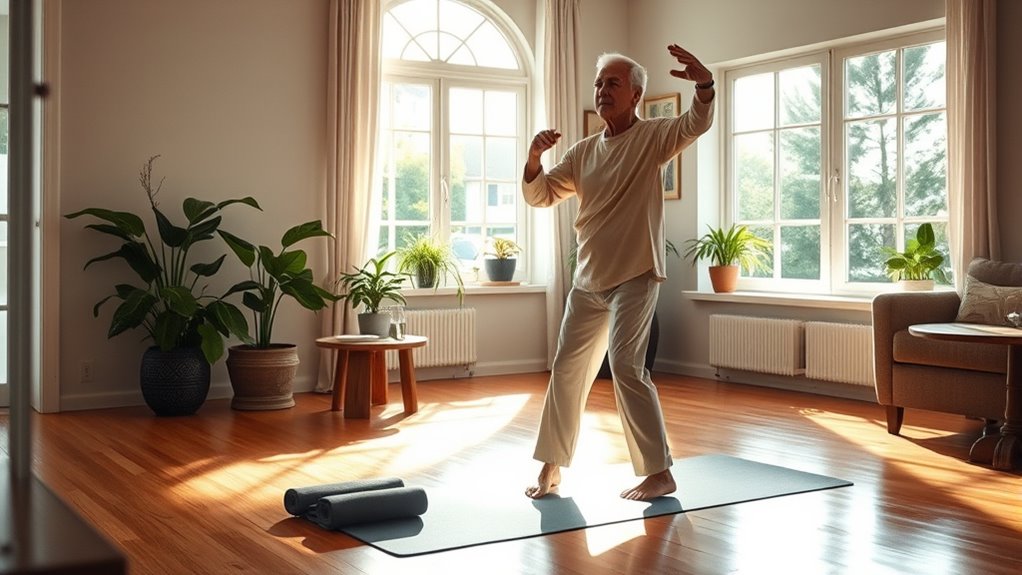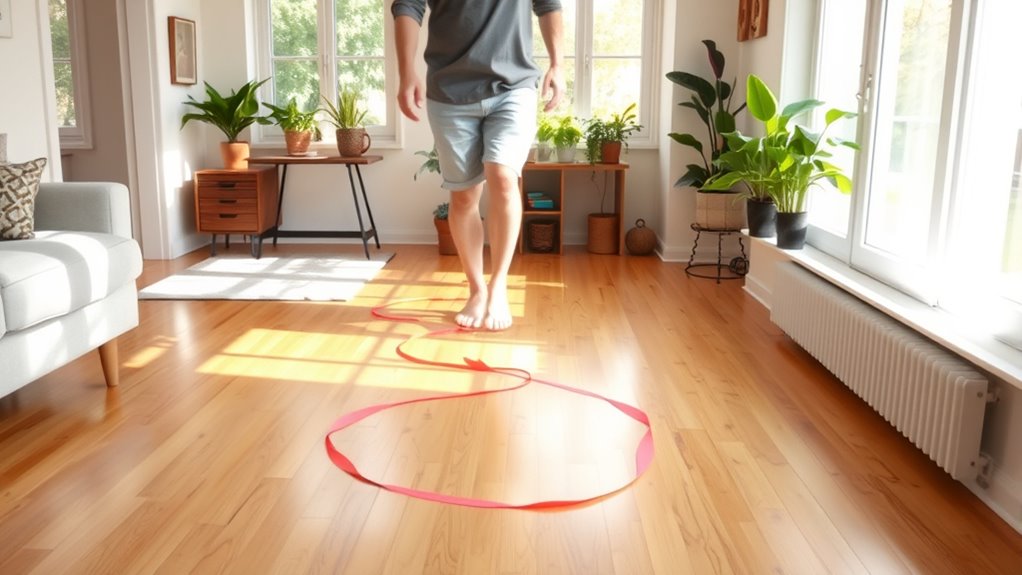To adopt Blue Zones movement patterns at home, focus on incorporating daily, low-intensity activities like walking, gardening, and light housework. Prioritize consistent movement throughout the day rather than intense workouts. Include simple stretches for major muscle groups to improve flexibility and reduce stiffness. Making these habits part of your routine supports long-term mobility and well-being. Keep going, and you’ll discover practical ways to stay active and healthy for years to come.
Key Takeaways
- Incorporate daily low-intensity activities like walking or gardening to maintain consistent movement.
- Practice gentle stretching routines targeting major muscles such as legs, arms, and back.
- Engage in regular movement patterns like morning walks or light household chores.
- Prioritize sustainable, enjoyable activities that promote mobility without overexertion.
- Maintain consistency in daily routines to support long-term flexibility and physical independence.

Many of the world’s longest-lived communities share common movement patterns that contribute to their health and significance. One key aspect is maintaining elderly mobility, which helps keep your body flexible, strong, and functional as you age. Rather than waiting for aches or stiffness to set in, incorporating simple movement routines into your daily life can make a big difference. Daily stretching is a cornerstone of these routines, helping to improve flexibility, reduce injury risk, and promote circulation. When you dedicate a few minutes each day to stretching, you’re actively supporting your body’s natural ability to move freely and comfortably.
Maintaining mobility through daily stretching supports longevity and keeps your body flexible and strong as you age.
You don’t need fancy equipment or lengthy workouts to benefit from daily stretching. Instead, focus on gentle, deliberate movements that target your major muscle groups—arms, legs, back, and neck. For example, stretching your hamstrings and calves can enhance leg mobility, making walking and other activities easier. Shoulder rolls and arm stretches keep your upper body limber, which is essential for everyday tasks like reaching or lifting. Incorporate slow, controlled breathing into each stretch to maximize relaxation and blood flow. This routine doesn’t have to take more than five or ten minutes, but the impact on your elderly mobility can be profound, helping you stay active and independent longer.
In addition to daily stretching, adopting movement patterns from Blue Zones — regions with high longevity — encourages you to stay active throughout the day. These communities prioritize regular, low-intensity activity, like walking and gardening, over intense workouts. By integrating more movement into your routines—whether it’s a morning walk, standing while talking on the phone, or light housework—you’re continually engaging your muscles and joints. This steady activity supports elderly mobility, making daily tasks easier and less taxing on your body. Over time, these habits become second nature, helping you preserve your vitality well into older age.
The key is consistency. When you make daily stretching and regular movement a part of your routine, you’re not just preventing stiffness—you’re actively promoting longevity and quality of life. Think of it as a small investment in your future self. As you age, these practices help maintain your independence, reduce the risk of falls, and improve overall well-being. By adopting movement patterns inspired by Blue Zones communities, you’re aligning yourself with a simple, sustainable approach to health. So, start today: dedicate a few minutes to stretch, move, and nurture your body. Your future self will thank you.
Engaging in these simple yet effective routines can also extend bulb lifespan, ensuring your equipment functions well for longer periods.
Frequently Asked Questions
How Do Blue Zones Movement Patterns Differ From Typical Exercise Routines?
Blue Zones movement patterns focus on integrating activity naturally into your daily life, unlike typical exercise routines that often involve structured workouts. You avoid a sedentary lifestyle by staying active through simple, consistent movements like walking, gardening, or doing chores. This approach makes movement feel like a regular part of your day, rather than a separate, scheduled workout, helping you stay healthier and more energized without the need for formal exercise sessions.
Can These Movement Patterns Prevent Age-Related Mobility Issues?
They say, “An ounce of prevention is worth a pound of cure.” Blue Zones movement patterns can help prevent falls and maintain flexibility as you age. By incorporating regular, gentle activities like walking and stretching into your daily routine, you support your mobility and reduce age-related decline. Staying active in these ways keeps you independent longer, proving that consistent movement truly makes a difference in aging gracefully.
Are These Patterns Suitable for People With Limited Mobility or Health Conditions?
If you have limited mobility or health conditions, you should consider adaptation strategies to safely incorporate movement patterns. These strategies help you tailor exercises to your abilities and address mobility considerations. Always consult with a healthcare professional before starting new routines, and focus on gentle, achievable movements. Doing so guarantees you can enjoy the benefits while minimizing risk, making movement safer and more effective for your unique needs.
How Long Does It Take to See Health Benefits From Adopting These Patterns?
Timing transforms your trajectory; with consistent lifestyle adoption, you’ll start to see tangible benefits in just a few weeks. Typically, the timeline benefits appear within 3 to 4 weeks, but it varies based on your effort and initial health. Keep committed, and you’ll notice improvements in energy, mood, and overall wellness sooner than you think. Patience and persistence perfect your progress, proving that small steps lead to significant strides.
What Are Simple Ways to Incorporate Blue Zones Movements Into Daily Life?
To incorporate Blue Zones movement patterns into your daily life, start with simple steps. Include daily stretching to improve flexibility and reduce stress. Turn household chores into mini-workouts by moving more intentionally—vacuuming, gardening, or cleaning. Make movement a habit by setting reminders or pairing it with daily routines. These small, consistent changes boost your health gradually and make staying active enjoyable and manageable.
Conclusion
By adopting these Blue Zones movement patterns, you transform your daily routine into a gentle, flowing river of activity that sustains your vitality. Think of movement as the melody that keeps your life’s song lively and harmonious. Embrace these habits at home, and watch as your health blossoms like a well-tended garden—thriving and full of life. Small steps today create a strong, vibrant tomorrow, turning ordinary days into extraordinary ones.











